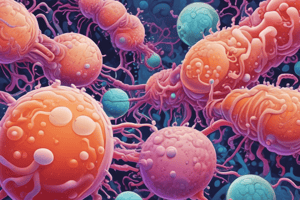Podcast
Questions and Answers
Staphylococcus aureus is the least important human pathogen among the Staphylococci family.
Staphylococcus aureus is the least important human pathogen among the Staphylococci family.
False (B)
The genus Staphylococcus is derived from the Greek words 'Staphyle' meaning berry and 'Kokkos' meaning bunch of grapes.
The genus Staphylococcus is derived from the Greek words 'Staphyle' meaning berry and 'Kokkos' meaning bunch of grapes.
False (B)
Staphylococci are anaerobic bacteria.
Staphylococci are anaerobic bacteria.
False (B)
The optimal temperature for Staphylococci growth is 25°C.
The optimal temperature for Staphylococci growth is 25°C.
Staphylococci colonies on Blood agar are surrounded by a clear zone of alpha-hemolysis.
Staphylococci colonies on Blood agar are surrounded by a clear zone of alpha-hemolysis.
On MacConkey agar, Staphylococci colonies are larger than those on Nutrient agar.
On MacConkey agar, Staphylococci colonies are larger than those on Nutrient agar.
Staphylococcus aureus ferments lactose but not mannitol.
Staphylococcus aureus ferments lactose but not mannitol.
Mannitol salt agar is a useful selective medium for recovering Staphylococcus epidermidis from faecal specimens.
Mannitol salt agar is a useful selective medium for recovering Staphylococcus epidermidis from faecal specimens.
Staphylococcus aureus produces gas during the fermentation of glucose.
Staphylococcus aureus produces gas during the fermentation of glucose.
What is the characteristic of Neisseria morphology?
What is the characteristic of Neisseria morphology?
What is the primary function of vancomycin in selective media for Neisseria growth?
What is the primary function of vancomycin in selective media for Neisseria growth?
Which of the following Neisseria species can grow under anaerobic conditions?
Which of the following Neisseria species can grow under anaerobic conditions?
What is the purpose of colistin in selective media for Neisseria growth?
What is the purpose of colistin in selective media for Neisseria growth?
What is the optimal condition for Neisseria growth?
What is the optimal condition for Neisseria growth?
Which of the following media is not suitable for N. meningitidis growth?
Which of the following media is not suitable for N. meningitidis growth?
Flashcards are hidden until you start studying
Study Notes
Neisseria
- Gram-negative cocci, occurring in pairs (diplococci)
- Exclusively pathogenic for humans, typically found associated with or inside polymorphonuclear cells (PMNs)
- Two main species: Neisseria gonorrhoeae (gonococci) and Neisseria meningitidis (meningococci)
- Morphology: approximately 0.8 µm in diameter, kidney bean-shaped, flat or concave sides adjacent when in pairs
- Culture: grows on sheep blood agar, chocolate agar, and selective agar media
- Selective media contain vancomycin, colistin, and other inhibitory substances to suppress growth of commensal microorganisms
- N. gonorrhoeae requires enriched chocolate agar and/or selective media for optimal growth
- N. meningitidis grows on sheep blood agar as well as selective media
Growth Characteristics
- Neisseriae grow best under aerobic conditions
- Some Neisseria species (e.g., N. gonorrhoeae) can grow under anaerobic conditions as well
Staphylococcus
- Family: Micrococceae (consists of Gram-positive cocci, arranged as clusters)
- Genus: Staphylococcus
- Term "staphylococcus" derived from Greek: Staphyle = bunch of grapes, and Kokkos = berry, meaning bacteria occurring in grape-like clusters or berry
- Staphylococcus aureus is the most important human pathogen (Coagulase-Positive staphylococci)
- Other important human pathogens: coagulase-negative staphylococci (CNS), including Staphylococcus epidermidis, Staphylococcus saprophyticus, and Staphylococcus haemolyticus
Culture and Biochemical Properties
- Aerobes and facultative anaerobes
- Optimal temperature for growth: 37°C
- Optimal pH for growth: 7.5
- Colony characteristics:
- On Nutrient agar: golden yellow, opaque, smooth, and glistening surface, 1-2 mm in diameter
- On Blood agar: golden yellow colonies, surrounded by a clear zone of hemolysis (beta-hemolysis), especially when incubated in sheep or rabbit blood agar in an atmosphere of 20% CO2
- On MacConkey agar: smaller colonies than those on NA (0.1-0.5 mm), pink-colored due to lactose fermentation
- On Mannitol salt agar: S. aureus ferments mannitol, appearing as yellow colonies
- Biochemical properties:
- Catalase: positive
- Oxidase: negative
- Ferments: glucose, lactose, maltose, sucrose, and mannitol, with production of acid but no gas
Studying That Suits You
Use AI to generate personalized quizzes and flashcards to suit your learning preferences.




